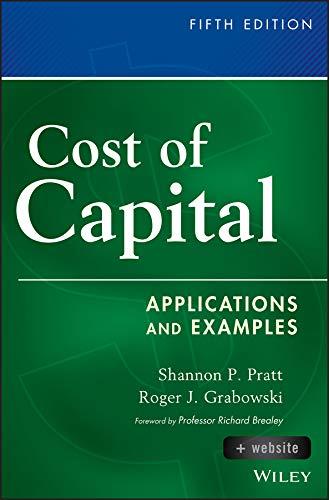Answered step by step
Verified Expert Solution
Question
1 Approved Answer
Bailey p171- 172 Question: Thank you 7.2.1 Implications of the arbitrage principle: an example That the arbitrage principle has important implications for asset prices is
Bailey p171- 172
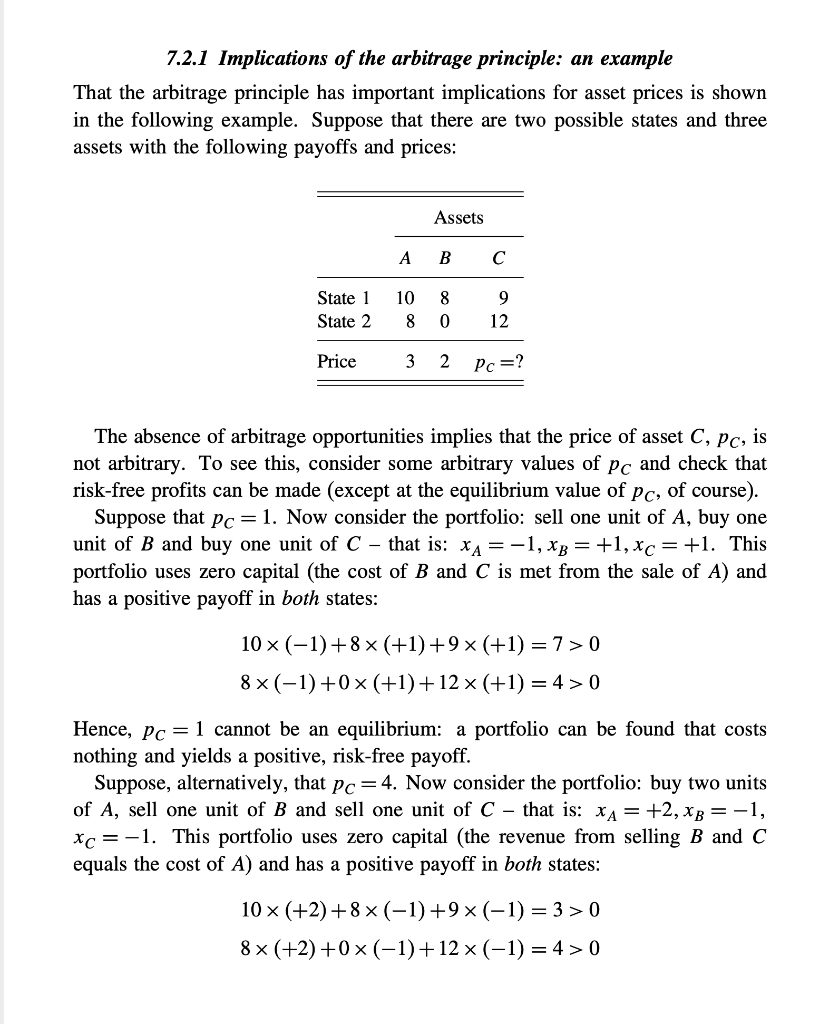
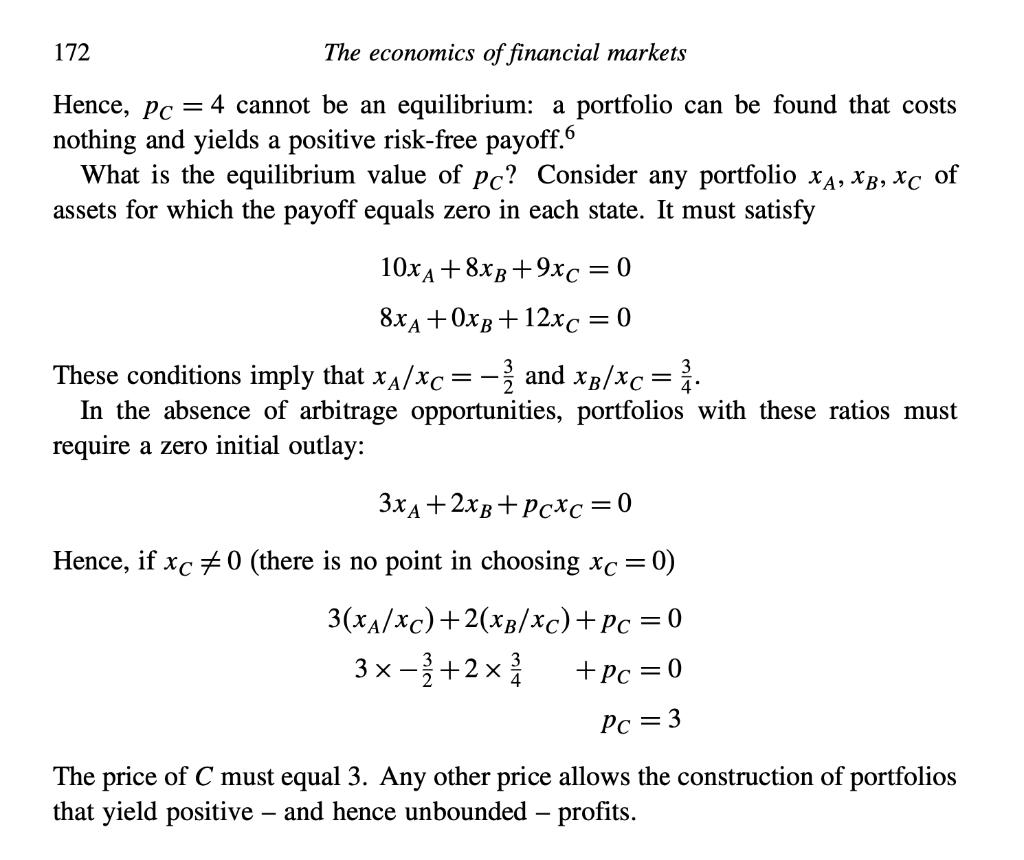
Question:
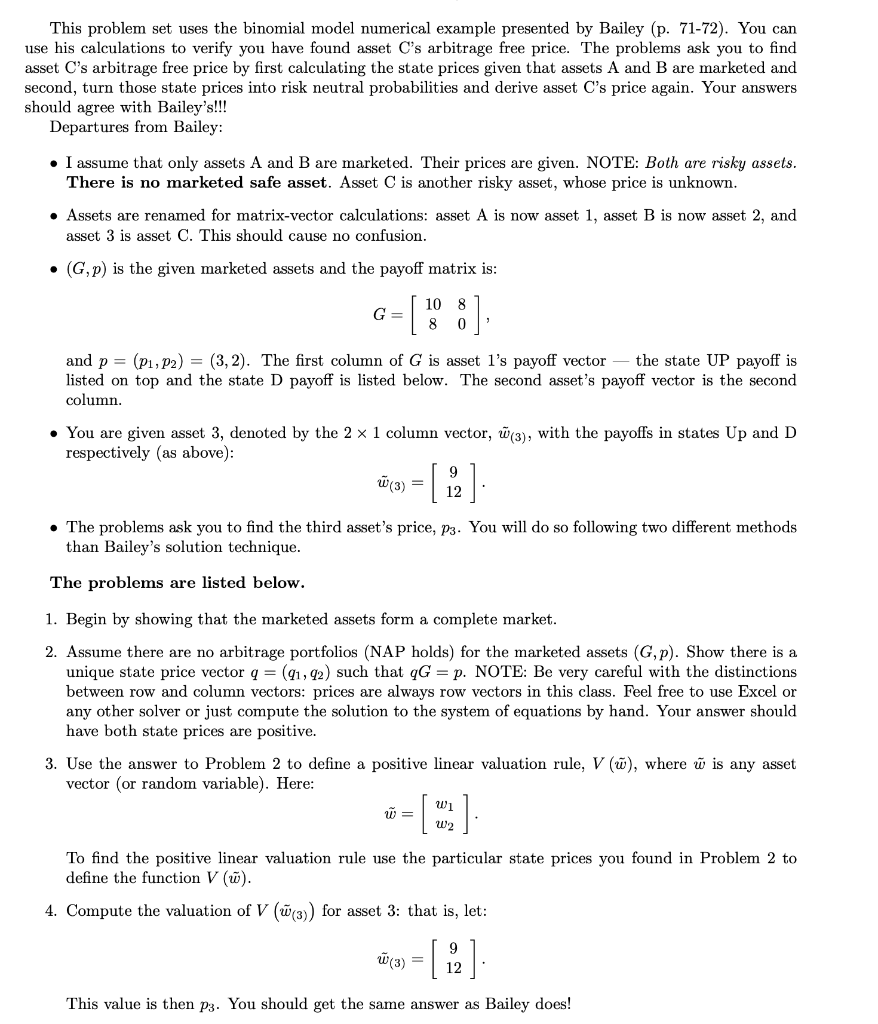
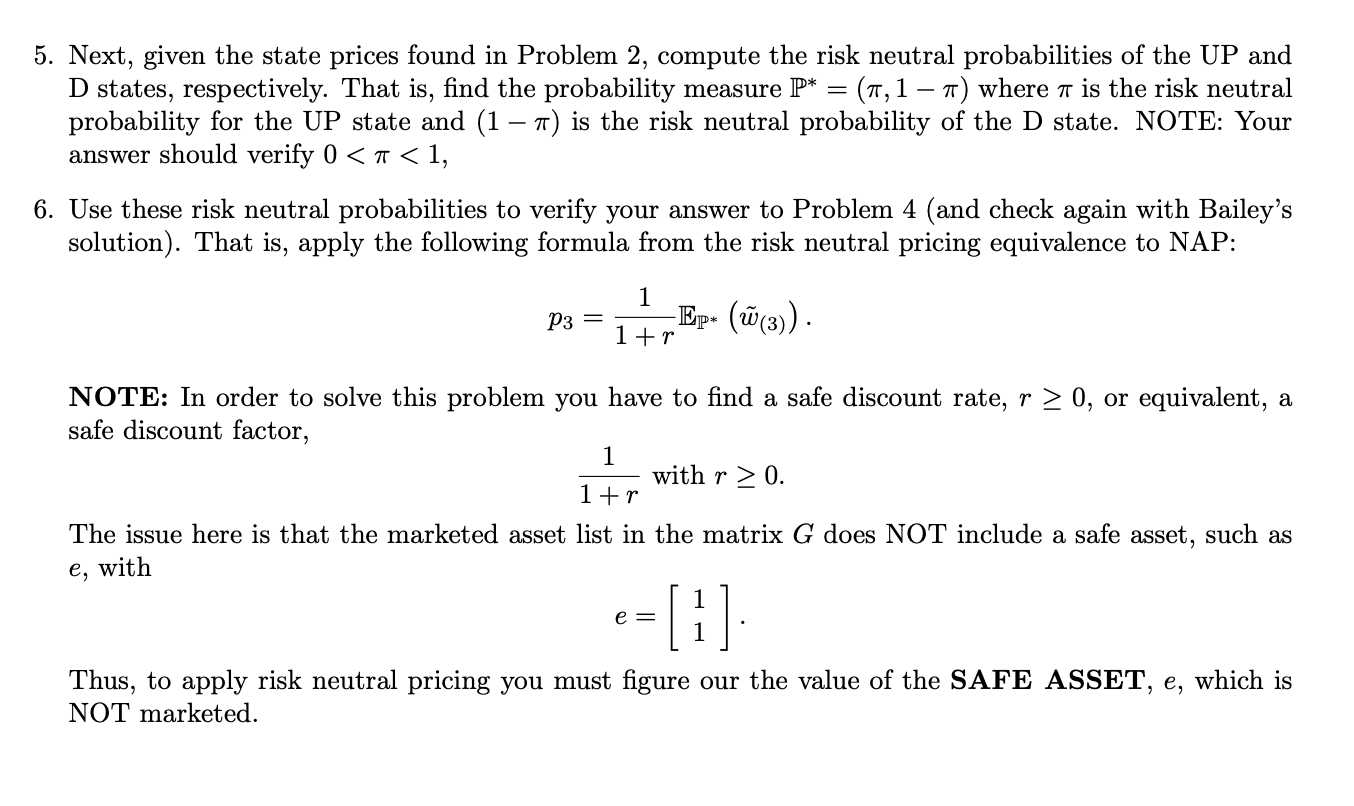
Thank you
7.2.1 Implications of the arbitrage principle: an example That the arbitrage principle has important implications for asset prices is shown in the following example. Suppose that there are two possible states and three assets with the following payoffs and prices: Assets A B 10 State 1 State 2 8 0 9 12 8 Price 3 2 Pc =? The absence of arbitrage opportunities implies that the price of asset C, pc, is not arbitrary. To see this, consider some arbitrary values of pc and check risk-free profits can be made (except at the equilibrium value of pc, of course). Suppose that Pc =1. Now consider the portfolio: sell one unit of A, buy one unit of B and buy one unit of C that is: XA=-1, xp = +1, xc = +1. This portfolio uses zero capital (the cost of B and C is met from the sale of A) and has a positive payoff in both states: 10 (-1)+8x(+1)+9x(+1)=7>0 8x(-1) +0x (+1)+12 x(+1) = 4>0 Hence, Pc = 1 cannot be an equilibrium: a portfolio can be found that costs nothing and yields a positive, risk-free payoff. Suppose, alternatively, that pc=4. Now consider the portfolio: buy two units of A, sell one unit of B and sell one unit of C - that is: XA= +2, x3 = -1, xc=-1. This portfolio uses zero capital (the revenue from selling B and C equals the cost of A) and has a positive payoff in both states: 10 x (+2)+8 (-1) +9(-1) = 3 > 0 8x(+2)+0x(-1) +12 x (-1) = 4> 0 172 The economics of financial markets Hence, pc = 4 cannot be an equilibrium: a portfolio can be found that costs nothing and yields a positive risk-free payoff. What is the equilibrium value of pc? Consider any portfolio xa, X3, Xc of assets for which the payoff equals zero in each state. It must satisfy 10xA +8x8 +9xc =0 8xA + 0x8+12xc 0 These conditions imply that xx/xc = and xb/xc = $. In the absence of arbitrage opportunities, portfolios with these ratios must require a zero initial outlay: 3xA + 2x +Pcxc=0 Hence, if xc #0 (there is no point in choosing xc=0) 3(xx/xc)+2(xb/xc)+Pc = 0 3x +2x +Pc = 0 Pc = 3 The price of C must equal 3. Any other price allows the construction of portfolios that yield positive - and hence unbounded profits. This problem set uses the binomial model numerical example presented by Bailey (p. 71-72). You can use his calculations to verify you have found asset C's arbitrage free price. The problems ask you to find asset C's arbitrage free price by first calculating the state prices given that assets A and B are marketed and second, turn those state prices into risk neutral probabilities and derive asset C's price again. Your answers should agree with Bailey's!!! Departures from Bailey: . I assume that only assets A and B are marketed. Their prices are given. NOTE: Both are risky assets. There is no marketed safe asset. Asset C is another risky asset, whose price is unknown. Assets are renamed for matrix-vector calculations: asset A is now asset 1, asset B is now asset 2, and asset 3 is asset C. This should cause no confusion. (G,p) is the given marketed assets and the payoff matrix is: G= 10 8 8 0 and p = (P1, P2) = (3,2). The first column of G is asset l's payoff vector the state UP payoff is listed on top and the state D payoff is listed below. The second asset's payoff vector is the second column. You are given asset 3, denoted by the 2 x 1 column vector, (3), with the payoffs in states Up and D respectively (as above): 9 W(3) = The problems ask you to find the third asset's price, p3. You will do so following two different methods than Bailey's solution technique. The problems are listed below. 1. Begin by showing that the marketed assets form a complete market. 2. Assume there are no arbitrage portfolios (NAP holds) for the marketed assets (G,p). Show there is a unique state price vector q = (91,92) such that G = p. NOTE: Be very careful with the distinctions between row and column vectors: prices are always row vectors in this class. Feel free to use Excel or any other solver or just compute the solution to the system of equations by hand. Your answer should have both state prices are positive. 3. Use the answer to Problem 2 to define a positive linear valuation rule, V (w), where w is any asset vector (or random variable). Here: wi W2 To find the positive linear valuation rule use the particular state prices you found in Problem 2 to define the function V (w). 4. Compute the valuation of V (3)) for asset 3: that is, let: 9 W(3) = This value is then p3. You should get the same answer as Bailey does! 5. Next, given the state prices found in Problem 2, compute the risk neutral probabilities of the UP and D states, respectively. That is, find the probability measure P* = (1,1 7) where a is the risk neutral probability for the UP state and (1 1) is the risk neutral probability of the D state. NOTE: Your answer should verify 0 0, or equivalent, a safe discount factor, 1 with r > 0. 1+r The issue here is that the marketed asset list in the matrix G does NOT include a safe asset, such as e, with e = [1] Thus, to apply risk neutral pricing you must figure our the value of the SAFE ASSET, e, which is NOT marketed. 7.2.1 Implications of the arbitrage principle: an example That the arbitrage principle has important implications for asset prices is shown in the following example. Suppose that there are two possible states and three assets with the following payoffs and prices: Assets A B 10 State 1 State 2 8 0 9 12 8 Price 3 2 Pc =? The absence of arbitrage opportunities implies that the price of asset C, pc, is not arbitrary. To see this, consider some arbitrary values of pc and check risk-free profits can be made (except at the equilibrium value of pc, of course). Suppose that Pc =1. Now consider the portfolio: sell one unit of A, buy one unit of B and buy one unit of C that is: XA=-1, xp = +1, xc = +1. This portfolio uses zero capital (the cost of B and C is met from the sale of A) and has a positive payoff in both states: 10 (-1)+8x(+1)+9x(+1)=7>0 8x(-1) +0x (+1)+12 x(+1) = 4>0 Hence, Pc = 1 cannot be an equilibrium: a portfolio can be found that costs nothing and yields a positive, risk-free payoff. Suppose, alternatively, that pc=4. Now consider the portfolio: buy two units of A, sell one unit of B and sell one unit of C - that is: XA= +2, x3 = -1, xc=-1. This portfolio uses zero capital (the revenue from selling B and C equals the cost of A) and has a positive payoff in both states: 10 x (+2)+8 (-1) +9(-1) = 3 > 0 8x(+2)+0x(-1) +12 x (-1) = 4> 0 172 The economics of financial markets Hence, pc = 4 cannot be an equilibrium: a portfolio can be found that costs nothing and yields a positive risk-free payoff. What is the equilibrium value of pc? Consider any portfolio xa, X3, Xc of assets for which the payoff equals zero in each state. It must satisfy 10xA +8x8 +9xc =0 8xA + 0x8+12xc 0 These conditions imply that xx/xc = and xb/xc = $. In the absence of arbitrage opportunities, portfolios with these ratios must require a zero initial outlay: 3xA + 2x +Pcxc=0 Hence, if xc #0 (there is no point in choosing xc=0) 3(xx/xc)+2(xb/xc)+Pc = 0 3x +2x +Pc = 0 Pc = 3 The price of C must equal 3. Any other price allows the construction of portfolios that yield positive - and hence unbounded profits. This problem set uses the binomial model numerical example presented by Bailey (p. 71-72). You can use his calculations to verify you have found asset C's arbitrage free price. The problems ask you to find asset C's arbitrage free price by first calculating the state prices given that assets A and B are marketed and second, turn those state prices into risk neutral probabilities and derive asset C's price again. Your answers should agree with Bailey's!!! Departures from Bailey: . I assume that only assets A and B are marketed. Their prices are given. NOTE: Both are risky assets. There is no marketed safe asset. Asset C is another risky asset, whose price is unknown. Assets are renamed for matrix-vector calculations: asset A is now asset 1, asset B is now asset 2, and asset 3 is asset C. This should cause no confusion. (G,p) is the given marketed assets and the payoff matrix is: G= 10 8 8 0 and p = (P1, P2) = (3,2). The first column of G is asset l's payoff vector the state UP payoff is listed on top and the state D payoff is listed below. The second asset's payoff vector is the second column. You are given asset 3, denoted by the 2 x 1 column vector, (3), with the payoffs in states Up and D respectively (as above): 9 W(3) = The problems ask you to find the third asset's price, p3. You will do so following two different methods than Bailey's solution technique. The problems are listed below. 1. Begin by showing that the marketed assets form a complete market. 2. Assume there are no arbitrage portfolios (NAP holds) for the marketed assets (G,p). Show there is a unique state price vector q = (91,92) such that G = p. NOTE: Be very careful with the distinctions between row and column vectors: prices are always row vectors in this class. Feel free to use Excel or any other solver or just compute the solution to the system of equations by hand. Your answer should have both state prices are positive. 3. Use the answer to Problem 2 to define a positive linear valuation rule, V (w), where w is any asset vector (or random variable). Here: wi W2 To find the positive linear valuation rule use the particular state prices you found in Problem 2 to define the function V (w). 4. Compute the valuation of V (3)) for asset 3: that is, let: 9 W(3) = This value is then p3. You should get the same answer as Bailey does! 5. Next, given the state prices found in Problem 2, compute the risk neutral probabilities of the UP and D states, respectively. That is, find the probability measure P* = (1,1 7) where a is the risk neutral probability for the UP state and (1 1) is the risk neutral probability of the D state. NOTE: Your answer should verify 0 0, or equivalent, a safe discount factor, 1 with r > 0. 1+r The issue here is that the marketed asset list in the matrix G does NOT include a safe asset, such as e, with e = [1] Thus, to apply risk neutral pricing you must figure our the value of the SAFE ASSET, e, which is NOT marketedStep by Step Solution
There are 3 Steps involved in it
Step: 1

Get Instant Access to Expert-Tailored Solutions
See step-by-step solutions with expert insights and AI powered tools for academic success
Step: 2

Step: 3

Ace Your Homework with AI
Get the answers you need in no time with our AI-driven, step-by-step assistance
Get Started


